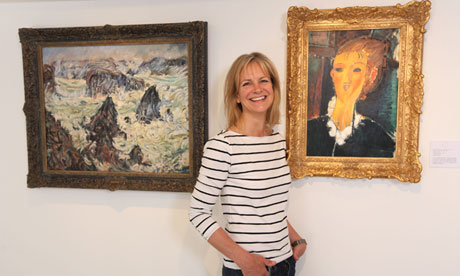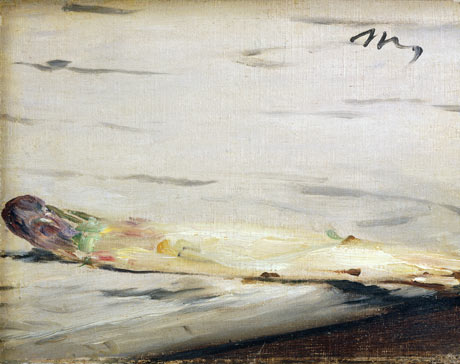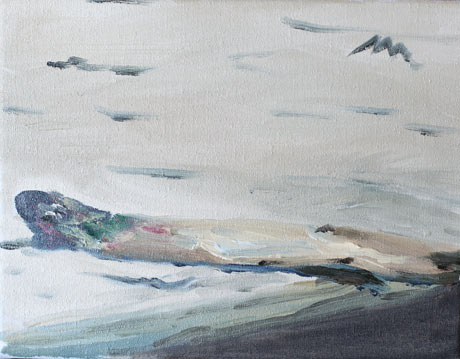Cameron's newest / old rehashed idea to stop teenagers looking at porn on the internet is yet another plan which only made me shout loudly at my poor, innocent radio. My teenager already knows more about the internet and probably porn than I ever will.
 Susie Ray with her copies of Monet’s Storm on Belle-Ile and Modigliani’s Jeune Femme à la Collerette. Photograph: Mark Passmore/Apex
Susie Ray with her copies of Monet’s Storm on Belle-Ile and Modigliani’s Jeune Femme à la Collerette. Photograph: Mark Passmore/Apex
 Asparagus, 1880, by Édouard Manet. Photograph: De Agostini/Getty Images
Asparagus, 1880, by Édouard Manet. Photograph: De Agostini/Getty Images
 Asparagus, 2013, by Stuart Jeffries. Yours for £20. Photograph: Mark Passmore/Apex
Asparagus, 2013, by Stuart Jeffries. Yours for £20. Photograph: Mark Passmore/Apex
But this headlline is actually from todays Guardian and features an article about the work of my mate Susie who I first met at Chelsea Art College and I'm still very proud of her:
"There's a problem with the copy I'm making of Édouard Manet's Asparagus, one of the most insouciant of his still lifes. The great Frenchman painted a single stalk lying coquettishly on a table. Mine looks more like a fish that's flopped out of a toxic sea to commit suicide. Or, if you look at it from a different angle, a penis at rest after a busy afternoon. It's certainly more animal than it should be.
"Not bad," says Susie Ray as we examine the results at her studio in Padstow, Cornwall. An upbeat sort of person, Ray is a copyist artist, meaning she has spent 25 years meticulously copying Manets, Monets, Renoirs, Modiglianis, Sisleys, Van Goghs and other artists who have been dead for more than 70 years (that's when their work comes out of copyright). She sells the results for £600 (for a sketch) to £9,000 (for the most laborious copy). Her pricing structure is based not on the original's market value, but the time it takes her to paint the copy. Who buys them? Celebrities and politicians apparently, as well as Russian millionaires keen to fill the wall-space on their yachts. "I'll also get commissioned by collectors who have a hole in their collection that can't be filled because the original isn't for sale," she says.
Ray, 55, has just opened what she claims to be the world's first copyist art gallery, Susie Ray Originals, in Padstow, and has agreed to give me a lesson, to give an insight into her craft. The gallery will teem this summer, no doubt, with the kind of posher holidaymakers who, after lunching at one of Rick Stein's many joints, might be tempted to spend £3,900 (including VAT) on her copy of Renoir's Onions. Buy it and you could astound your friends by passing it off as original (best tell your contents insurer the truth, though). Her surfer dude partner Ollie May tells me that wives are forever dragging their husbands into the gallery, saying: "They're selling Monets for £8,000!"
Across the street, a woman who does paintings of cartoon cows seems to have cornered the sizable seaside novelty market. She's not, one suspects, courting the same demographic as Ray.

While she won't name many of her clients, Ray does reveal that DJ Bruno Brookes and chef Marco Pierre White rank among them. She was once commissioned to do a copy of Van Gogh's Vase with Gladioli for Dame Edna Everage. Gladioli-accessorising miserabilist Morrissey would probably like a copy of that, too, but he's out of luck: Ray doesn't do duplicates, as a matter of principle.
But isn't this forgery? Isn't Ray's whole oeuvre that of a cynical charlatan? "I'm not a forger," she says, arguing that she's different from, say, the notorious cockney forger Tom Keating, who avoided jail even after admitting to painting 2,000 fakes of old masters. On the back of each copy, Ray signs her name. Real forgers don't do that. That said, she tells me some of her clients have passed off her copies as the real thing, if not to make money then to show off to dinner guests. One household name (whose identity I can't reveal) loves to boast about his Claude Monet – when it's really his Susie Ray. But isn't Ray facilitating such grubby behaviour? "A lot of famous people pass off my copies as original," she says. "That's up to them."
You could have been a lot richer, I add, had you followed Keating's path. "In jail more likely," she retorts. "Tom Keating wasn't a very good forger. The only reason he got away with it is that he was copying in an era when the reproductions weren't very good. People didn't know how unlike the originals his versions were. I don't have that luxury."
I've spent two hours trying to replicate Manet's Asparagus, the simplest impressionist masterpiece Ray could find for me to copy. The original, in the Musée d'Orsay in Paris, is a cute art-world joke: in 1880, Manet sold collector Charles Ephrussi A Bunch of Asparagus for 800 francs. Ephrussi sent him 1,000 francs, so Manet painted this extra stalk and sent it off with a note: "There was one missing from your bunch."
My shambles contrasts sharply with the technical mastery of the canvas hanging on the wall behind me: Ray's copy of a painting from Monet's series Cabane des douaniers, effet d'après-midi. "The title sounds better in French," she says. "Customs shack in the afternoon doesn't have quite the same ring." I wonder how much a Monet copy would shift for, but this customs shack's not for sale.
I'm working from three coloured prints Ray has sourced, each one tonally very different from the other, with one cropping out the asparagus altogether. Ray has done a rough sketch and helps me mix some paints. I've never painted in oils before and am on a steep learning curve, but what I'm mostly acquiring is a profound appreciation of Manet. Just look at the illusion of solidity he creates at one end of the spear with just two brushstrokes. Damn him. My version is hopeless. It's starting to look like a seagull.

"It would have taken Manet about four hours to paint, I suspect," says Ray. A copy could take her up to five weeks, what with drying times, overpainting and adding some mysterious goo from a jam jar to make it look as if it were painted in 1880 Paris rather than 2013 Padstow. Ray specialises in impressionist art, partly because she loves that era, and partly because copies are easy to sell. They are not easy to do, though, but the challenge adds to their allure. "It's more painstaking for me to replicate an impressionist painting than an old master. I know someone who does Vermeers and Rembrandts. That's fairly straightforward. You can correct where you've gone wrong more easily. They're time-consuming, painstakingly built up, but they're not beyond me technically. With impressionist works, you have to copy what they did quickly and freely, while still being meticulous. Very difficult." Anybody you can't copy? "Pollock. The drips aren't going to be the same." Rothko is also tricky. "The scumbling is incredibly difficult to copy, the different colours peeping through the layers – nightmare. But everybody thinks their kid could do Rothko. They haven't really looked hard enough."
Ray made her career from looking hard and painstakingly copying what she saw. Even though she's of the right generation to be a YBA, she isn't of that temper. She despises Hirst and Emin. She's never heard of artists doing similar work, such as photographer Louise Lawler and Mike Bidlo, whose copies of and portraits of other artist's work serve to problematise the notions of authenticity, originality, genius and art-world commodification. Ray's art doesn't roll that way.
Intriguingly, though, Bidlo copied what banjaxed Ray. He made some Pollock drip paintings and, in a 1982 show called Jack the Dripper at Peg's Place, re-enacted Pollock urinating into Peggy Guggenheim's fireplace. Naughty boy.
Born on the Lizard peninsula, Ray was educated at convent school and then trained at Chelsea College of Art and Middlesex Polytechnic, graduating with a first-class degree in scientific illustration.
In the early 1980s, she worked for a pittance as a botanical illustrator at Kew Gardens. "I got £70 a painting, which would take 10 days to produce." It was a good grounding. "I was painting in watercolours and you can't correct a mistake easily so there was a premium on getting it right first time." She also illustrated seashore guidebooks for Collins Gem, channelling not just her scientific illustrator skills but her Cornish beachcombing past.
By the late 1980s, while her contemporaries at Goldsmiths were fomenting a Britart revolution, Ray had established herself at a gallery in Drury Lane doing copies of Renoir, Monet, Caravaggio, Stubbs, Gauguin and Modigliani. She became the artist in residence for the British Museum's 1990 show Fake?: The Art of Deception.
Today Ray denies her business is fakery. Her true precursors, she says, are the 1880s artists who worked copying paintings in the Louvre. "I do work in some grey areas, though," she concedes. She has been commissioned to copy Bacons and Picassos so that collectors, whom she declines to name, can store the originals in vaults. "By replacing it with my copy the work can still be enjoyed while the original is safely locked away."

Don't you feel creatively thwarted? Isn't art about using your talents to express yourself rather than slavishly copying another's genius? "I've tried my own paintings but they're no good. I'm very critical of everything I do. I'm an illustrator not a fine artist.
"People think I make a lot of money from what I do. I don't really, I do it because I love it."
I take a final glance around Ray's gallery. On an easel is a Samuel Peploefloral still life. Ray recently started copying the Scottish post-impressionist painter's works because, as he died in 1935, his oeuvre has been out of copyright since 2005. I look in awe at her copy of Manet's A Bunch of Asparagus, the painting for which critic-collector Ephrussi overpaid 200 francs. The original is in Cologne's Wallraf-Richartz-Museum. If you wanted your own copy, you could order an oil painting from an online supplier for $214.20. I couldn't vouch for its quality. Or you could have the copy hanging in Ray's gallery in a rather lovely frame for £3,900.
Here's a better idea. Wait a couple of weeks until my copy of Manet's Asparagus has dried. The critics (well, my partner) are already calling it a masterpiece. Actual quote? "It's a masterpiece – if it's meant to be a dead whale." Look a treat in your loo. Twenty quid plus p&p? Don't tell me you're not tempted."

No comments:
Post a Comment